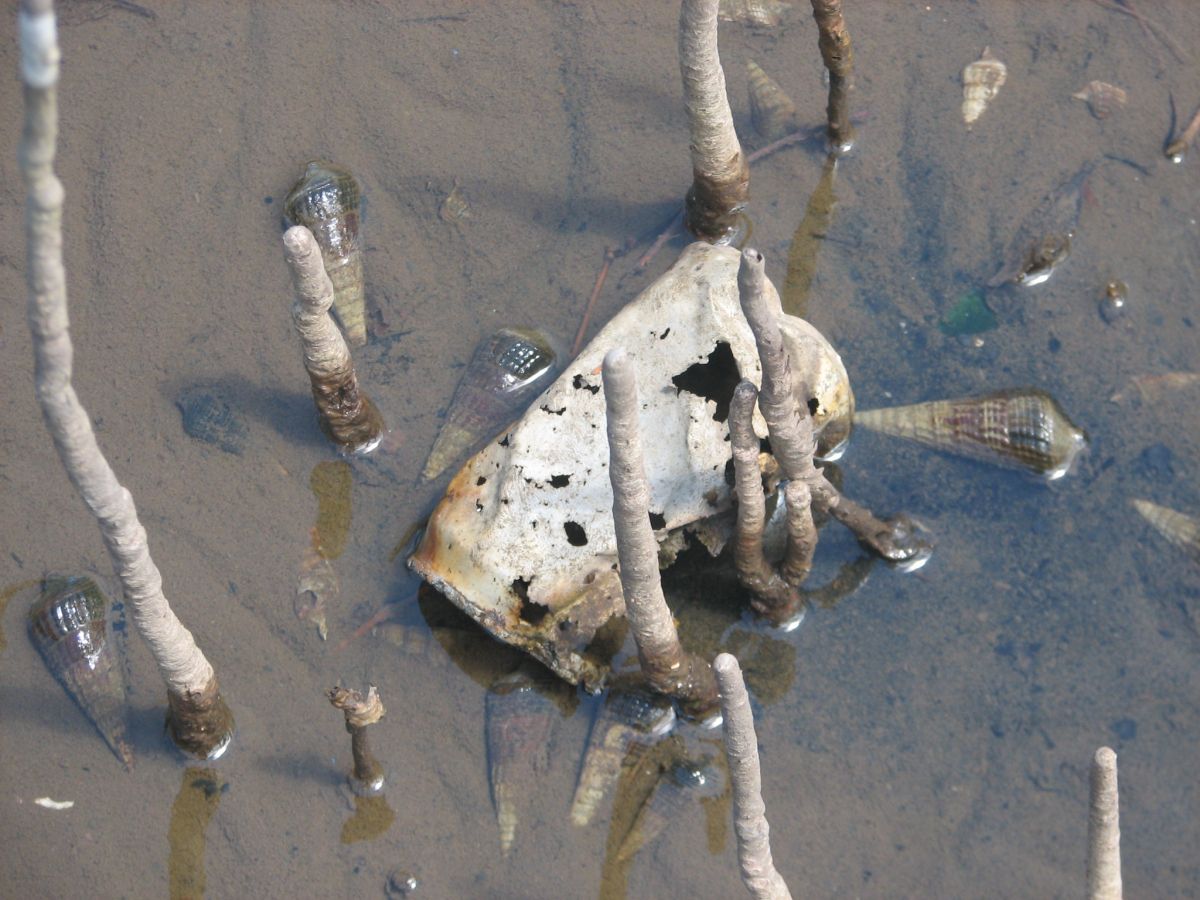
On considère souvent qu'une canette abandonnée dans la nature est altérée au minimum en un siècle ; dans certaines mangroves, elle disparaît en quelques années seulement. Photo prise à Canala.
Pratique
Références bibliographiques
Burns, K.A., Codi, S. & Duke, N.C., 2000.- Gladstone, Australia field studies: Weathering and degradation of hydrocarbons in oiled mangrove and salt marsh sediments with and without the application of an experimental bioremediation protocol. Marine Polution Bulletin, 41 : 392-402. http://espace.library.uq.edu.au/view/UQ:167566
Duke, N.C., 1997.- Mangrove restoration in Panama : an evaluation of planting in areas deforested by large oil spill. In : Field C. (ed.) - Restoration of mangrove ecosystems. Okinawa, ISME/ITTO : 209-232.
Herteman, Mélanie, 2010.- Evaluation des capacités bioremédiatrices d'une mangrove impactée par des eaux usées domestiques. Application au site pilote de Malamani, Mayotte. Université Paul Sabatier-Toulouse III, thèse de doctorat, 290 p. + annexes.
http://tel.archives-ouvertes.fr/docs/00/56/38/02/PDF/These_Mangrove-Herteman_2010.pdf
Levings, S.C., Garrity, S.D., Burns, K.A., 1995.- The 1986 Bahia Las Minas Oil Spill: Summary Results from the Red Mangrove (Rhizophora mangle) Fringe. In: Gulf of Mexico and Caribbean Oil Spills in Coastal Ecosystems: Assessing Effects, Natural Recovery, and Progress in Remediation Research. (OCS Study/MMS 95-0063) Eds: Proffitt, CE., Roscigno, PF) U.S. Dept. of the Interior, Minerals Management Service, Gulf of Mexico OCS Region, New Orleans, LA, 80-98.
McFarlane, G.R., Burchett, M., 1999.- Zinc distribution and excretion in theleaves of the Grey mangrove, Avicenia marina (Forsk.) Vierh. Environ. Exp. Bot. 41: p. 167–175.
McKee, K.L., Faulkner, P.L., 2000.- Restoration of Biogeochemical Function in Mangrove Forests. Restoration Ecology, Vol. 8, Issue 3 : 247-25.
Norris, R.D., Hinchee, R.E., Brown, R., McCarty, P.L., Semprini, L., Wilson, J.T., Kampbell, D.H., Reinhard, M., Bouwer, E. J., Borden, R.C., Vogel, T.M., Thomas, J.M., Ward, C.H., 1994.- Handbook of Bioremediation. Boca Raton, Lewis Publishers, 257 p. [Robert S. Kerr Environmental Research Laboratory, Ada, Oklahoma]
Neto Ferreira Gomes, D., 2007.- Diversidade e potencial biotecnológico de fungos filamentosos isolados do manguezal Barra das Jangadas, Jaboatão dos Guararapes, Pernambuco. Recife, Université du Pernambouc, thèse, 94 p. http://www.bdtd.ufpe.br/tedeSimplificado//tde_busca/arquivo.php?codArquivo=1907 (texte intégral en portugais)
Odokuma, L.O., Dickson, A.A., 2003.- Bioremediation of a Crude Oil Polluted Tropical Mangrove Environment. Journal of Applied Sciences and Environmental Management 7 (2). http://books.google.fr/books?id=up9M7kvgWgIC&printsec=frontcover
Pi, N., Tam, NFY. & Wong MH., 2010.- Effects of wastewater discharge on iron plaque formation on root surface and radial oxygen loss of mangrove root. Environmental Pollution 158: 381-387
Proffitt, E.C., 1997.- Managing Oil Spills in Mangrove Ecosystems: Effects, Remediation, Restoration and Modeling. New Orleans, Report, p. http://www.gomr.boemre.gov/PI/PDFImages/ESPIS/3/3254.pdf
Proffitt, E.C. & Roscigno, P.F. (eds.)., 1995.- Proceedings - Gulf of Mexico and Caribbean Oil Spills in Coastal Ecosystems : Assessing Effects, Natural Recovery, and Progress in Remediation Research . OCS Study/MMS 95-0063 . U.S . Dept. of the Interior, Minerals Management Service, Gulf of Mexico OCS Region, New Orleans, LA.
Rabinowitz, D., 1978.- Dispersal properties of mangrove propagules. Biotropica, 10: p. 47-57 .
Ramsay, M.A., Swannell, RPJ., Shipton, WA., Duke, NC., Hill, RT., 2000.- Effect of bioremediation on the microbial community in oiled mangrove sediments. Marine Pollution Bulletin, 41 : 413-419. http://espace.library.uq.edu.au/view/UQ:139956
Tam, N.F.Y. & Wong, Y.S., 1995.- Mangrove soils as sinks for wastewater-borne pollutants. Hydrobiologia, 295 (1-3): 231-241.
Tam, N.F.Y. & Wong, Y.S., 1997.- Accumulation and distribution of heavy metals in a simulated mangrove system treated with sewage. Hydrobiologia, 352 : 61-75.
Tam, N.F.Y. & Wong, Y.S., 1999.- Mangrove soils in removing pollutants from municipal wastewater of different salinities. J. Env. Quality., 28 (2) : 556-564. http://jeq.scijournals.org/cgi/content/abstract/28/2/556
Tam, N.F.Y. & Wong, Y.S., 2008.- Effectiveness of bacterial inoculum and mangrove plants on remediation of sediment contaminated with polycyclic aromatic hydrocarbons. Marine Pollution Bulletin, 57: 716-726. http://cat.inist.fr/?aModele=afficheN&cpsidt=20683596
Weaver, R.W., Crites, B., Neralla, S., Wright, A. & Webb J.W., 1995.- Evaluation of commercial bioremediation products for oil biodegradation in salt marshes, In: Proffitt and Roscigno (eds.). Proceedings - Gulf of Mexico and Caribbean Oil Spills in Coastal Ecosystems : Assessing Effects, Natural Recovery, and Progress in Remediation Research . OCS Study/MMS 95-0063 . U.S . Dept. of the Interior, Minerals Management Service, Gulf of Mexico OCS Region, New Orleans, LA., p . 165-173.
Wong, Y.S., Tam, N.F.Y, Lan C.Y., 1997.- Mangrove wetlands as wastewater treatment facility: a field trial. Hydrobiologia, 352 (1-3) : 49-59. http://www.ingentaconnect.com/content/klu/hydr/1997/00000352/00000001/00142893
Wong, Y.S., Lan, C.Y., Chen, G.Z., Li, S.H., Che, X.R., Liu ,Z.P., Tam, N.F.Y., 1995.- Effect of wastewater discharge on nutrient contamination of mangrove soils and plants. Hydrobiologia, 295 : 1-3.
Yu, S.H., Ke, L., Wong, Y.S. & Tam, NFY, 2005.- Degradation of polycyclic aromatic hydrocarbons (PAHs) by a consortium enriched from mangrove sediments. Environment International, 31: 149-154
Version initiale, le 17 juillet 2009
Actualisé en décembre 2010, août 2011
